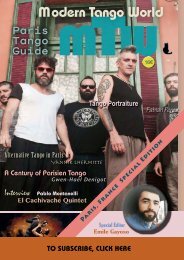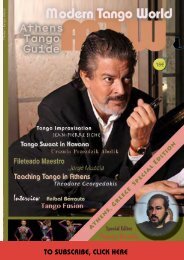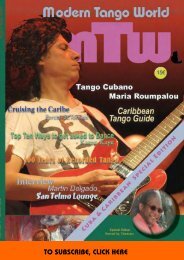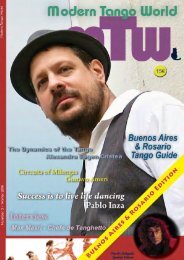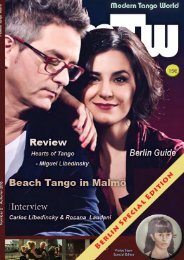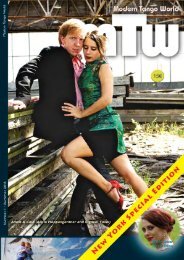Modern Tango World #8 (Moscow)
Moscow Special Features Magnolias on the Snow Andrey Klimovich 03 Milonga Chique Evgeny Morozow 10 The New Moscow Polina Yegurnova 14 Guide to Tango in Moscow 18 Sunset Tango Collages Denise Mumm 22 Interview with Jonathan Goldman Marco Buso 26 The Other Night at La Viruta Daniel Pereyra 31 Book Review: Tango Awareness Alexandru Eugen Cristea 34 Why There is so Little Dance in Dancing Tango Veronica Toumanova 35 New Tango Music Arndt Büssing 38 Tango Moves: Boleos (Voleos) Raymond Lauzzana 42 Letters to the Editor 46
Moscow Special Features
Magnolias on the Snow Andrey Klimovich 03
Milonga Chique Evgeny Morozow 10
The New Moscow Polina Yegurnova 14
Guide to Tango in Moscow 18
Sunset Tango Collages Denise Mumm 22
Interview with Jonathan Goldman Marco Buso 26
The Other Night at La Viruta Daniel Pereyra 31
Book Review: Tango Awareness Alexandru Eugen Cristea 34
Why There is so Little Dance in Dancing Tango Veronica Toumanova 35
New Tango Music Arndt Büssing 38
Tango Moves: Boleos (Voleos) Raymond Lauzzana 42
Letters to the Editor 46
Create successful ePaper yourself
Turn your PDF publications into a flip-book with our unique Google optimized e-Paper software.
In <strong>Moscow</strong>, there is what is called Alternative Practice<br />
on Sundays. The people, who attend, bring their own<br />
music and dance it. There is no real management of the<br />
music playlist. The event does not have a milonga format.<br />
This is a very interesting place that helps to expand the<br />
musical, emotional and dance scope of the participants.<br />
But I had wanted to raise it to another level with a fullfledged<br />
alternative milonga, with a unique atmosphere,<br />
sound quality and so on. The first milonga of this type<br />
appeared in <strong>Moscow</strong> on February 20, 2016. The organizers<br />
of Milonga Chique invited me to implement this<br />
on one of their two dance floors. As it turns out, this<br />
format works fine.<br />
It is worth noting that the word Nuevo in <strong>Moscow</strong> had<br />
acquired a negative, and even threatening sense in tango<br />
circles. It is usually understood as either monotonous<br />
electronic tango music, or heavy, chaotic and dramatic<br />
compositions of late Osvaldo Pugliese, or Astor Piazzolla.<br />
Nuevo was understood as very complex music<br />
that cannot be danced. There were some different, not<br />
very successful, experimental nuevo milongas in which<br />
rare, electronic, non-danceable music was played. It was<br />
clear that the DJ’s intention was to enlighten the people,<br />
opening them new music. It became clear that was inappropriate<br />
for particular audiences. It was often reduced<br />
to a chaotic, disorganized, unbalanced event with limited<br />
musical and emotional flow. Of course, it was stressful<br />
for people who came to dance. People associated this<br />
stress with the concept of nuevo.<br />
As practice has shown that a good tango-DJ, using only<br />
traditional tango, can create almost any mood on the<br />
dance floor, without using the alternative, modern, or<br />
nuevo music. It depends on the taste and ability to feel<br />
the dance floor, from empathy, emotionality, sound<br />
quality, and many other factors.<br />
However, the important point is that the expansion of<br />
the musical range is itself very interesting. It can open<br />
up new opportunities, ideas, inspiration and emotions<br />
for both the DJ and the dancers. This opens a completely<br />
different domain introducing other flows and<br />
energies! Currently, there are not too many people at<br />
milongas who can dance well to this music. Most people<br />
use traditional movements and combinations. But, the<br />
music inspires improvisation, and this is very important!<br />
Here is a good example from classical music. No doubt,<br />
that Bach, Beethoven, Tchaikovsky all represent classical<br />
music. But, these composers are very different! If you<br />
ask a person if they likes classical music, their answer will<br />
depend on whether they knows something about composers,<br />
years of their activity, genres within classics, and<br />
so on. But many people do not know anything about<br />
this. Their knowledge may be limited to the Moonlight<br />
Sonata, Fugue in D minor and Waltz of Flowers. Knowing<br />
only these few works, they form an opinion about all<br />
classical music. The situation is the same with the concept<br />
of Nuevo.. Some people think that it’s only Piazzolla,<br />
Gotan and Otros Aires. The word nuevo is translated<br />
as new. But, the genre includes a much larger range of<br />
music. Maybe, the term, Neo<strong>Tango</strong>, used by foreign colleagues,<br />
is more viable.<br />
— 13 —<br />
TO SUBSCRIBE, CLICK HERE




